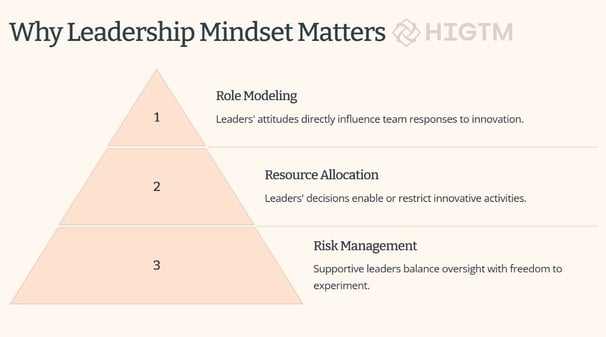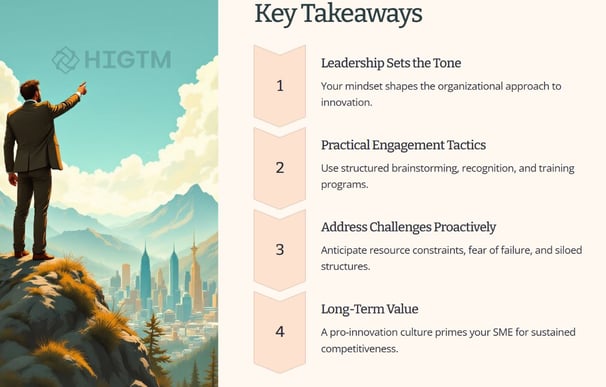13. Leadership Mindset – Fostering a Pro-Innovation Culture
For small and medium-sized enterprises (SMEs), developing this culture isn’t just about staying current—it’s about cultivating the agility and creativity that drive survival and growth. This post explores the key aspects of fostering a pro-innovation environment, the pivotal role of leadership mindset, practical ways to encourage innovative thinking, and how to overcome the most common obstacles. Ultimately, we hope to show that leader-driven curiosity, resource commitment, and a “fail-fast, learn-fast” approach can help SMEs adapt to new technology trends—like AI—while building a more resilient future.
Q1: FOUNDATIONS OF AI IN SME MANAGEMENT - CHAPTER 1 (DAYS 1–31): CORE AI CONCEPTS & VALUE PROPOSITION
Gary Stoyanov PhD
1/13/20255 min read

1. Defining Pro-Innovation Culture
A pro-innovation culture is one where every individual—from frontline employees to senior management—feels empowered to question the status quo, experiment with new processes, and champion continuous improvement. It’s not just about technology adoption; it’s about a broad mindset that values risk-taking, collaborative thinking, and rapid iteration.
1.1 Embracing Change
Key Concept: When organizations see change as an opportunity rather than a threat, they’re more willing to test and refine new ideas—including AI-led initiatives.
Practical Outcome: Employees feel safe pitching unconventional concepts or solutions, knowing leadership will offer constructive feedback rather than immediate dismissal.
1.2 Collaboration & Openness
Key Concept: Cross-departmental communication breaks silos, allowing diverse perspectives to merge into stronger, more creative solutions.
Practical Outcome: Marketing might share insights with operations on customer pain points, fueling AI-driven chatbots that address queries quickly and effectively.
1.3 Continuous Improvement
Key Concept: Nothing is seen as “final”; every process or product can be iterated upon.
Practical Outcome: Regular reviews to see how new tools (like AI recommendation engines) are performing, followed by data-driven enhancements to fine-tune performance.
In short, a pro-innovation culture harnesses collective intelligence, giving teams both the freedom to explore and the structure to implement. It’s the bedrock of sustainable modernization—particularly relevant when integrating AI or automation technologies.
2. Why Leadership Mindset Matters
Leadership is the guiding force that dictates an organization’s openness to experimentation, the resources it devotes to new initiatives, and how risks and failures are managed. If leaders resist innovation, no bottom-up effort is likely to succeed. Conversely, if leaders champion it, employees feel permission to unleash creativity.
2.1 Role Modeling
Leadership Behavior: When top-level managers embrace new ideas and demonstrate curiosity, employees are more likely to mirror that enthusiasm.
Signaling Importance: Visible interest in emerging solutions—like exploring AI’s potential to streamline inventory management—shows teams that innovation is a top priority.
Practical Example: A CEO who tests a pilot AI chatbot on the company website and shares preliminary results fosters excitement. Employees sense a genuine push to modernize, rather than lip service to the buzzword “AI.”
2.2 Resource Allocation
Budgets & Priorities: Leaders control how much time and money go into pilot projects or skill development. If leadership invests in the necessary training, hardware, or software, the message is clear: innovation matters.
Safe Time for Exploration: Dedicated “innovation hours” each week or small hackathons can embolden staff to develop new ideas without sacrificing daily duties.
Practical Example: An SME sets aside 5% of its annual budget for “innovation funds,” awarding mini-grants to departments testing new AI-driven process improvements. This financial support encourages even cautious staff to propose bold solutions.
2.3 Risk Management
Tolerance for Failure: Innovation usually involves trial and error. Supportive leaders accept minor failures if they bring valuable lessons or pave the way for future breakthroughs.
Fail Fast, Learn Fast: A mindful approach to risk doesn’t mean launching massive, high-stakes projects. Instead, small, controlled experiments yield insights while containing potential losses.
Practical Example: A marketing director tries out an AI-based lead scoring tool on a small subset of potential customers. If the pilot stumbles, the damage is minimal, but the lessons gained (improving data quality or refining targeting criteria) inform a better second attempt.
3. Tactics to Foster Innovation
Building a pro-innovation culture doesn’t happen by accident; it requires deliberate actions that engage employees, streamline collaboration, and systematically reward creativity. Below are four tactics that can transform your organizational mindset.
3.1 Structured Brainstorming & Hackathons
What It Is: Scheduled sessions or challenge-based events where teams tackle specific problems—be it operational inefficiencies or new product ideas.
Benefit: Forces people from different departments to cross-pollinate ideas, often unearthing synergy across skill sets.
Case Example: A mid-sized manufacturing SME hosts a quarterly “innovation day.” Cross-functional teams propose solutions—like using AI sensors for predictive maintenance. Winning ideas receive budget and leadership support for pilot testing.
3.2 Recognition & Rewards
What It Is: Publicly celebrating successes, large or small, to show that risk-taking and creative problem-solving are valued.
Benefit: Motivates employees to keep experimenting. Even small tokens—gift cards, extra time off, or a company-wide spotlight—can go a long way.
Case Example: An online retailer gives out a “Innovation Champion” award monthly to employees who adopt or recommend an AI tool that improves a KPI (like shipping time). This builds healthy competition and fosters morale.
3.3 Transparent Communication
What It Is: Leaders keep teams informed about strategic goals, upcoming changes, and how innovation fits into the bigger picture.
Benefit: Reduces rumors or misconceptions about new initiatives—like AI deployment—helping staff understand the why behind changes.
Case Example: Before rolling out an AI-driven inventory system, leadership holds a town hall explaining how data will be used, expected outcomes, and potential next steps. Employees can raise concerns and see how their roles evolve.
3.4 Upskilling & Training
What It Is: Formal or informal educational programs focused on emerging tech, problem-solving methods, or relevant AI fundamentals.
Benefit: Empowers employees to adapt confidently to new tools, bridging skill gaps that might otherwise stall progress.
Case Example: An HR department sponsors short courses on basic machine learning or data analytics. Even if staff aren’t building AI models, they gain context about how the technology works, dispelling fear or confusion.
4. Overcoming Common Challenges
Shifting to a pro-innovation culture can stir up resistance or other headwinds, especially in resource-constrained SMEs. Being aware of these pitfalls—and addressing them early—ensures smoother transitions.
4.1 Resistance to Change
Challenge: Staff may worry about job security or feel overwhelmed by adopting new methods.
Solution: Showcase small wins and tangible benefits—like how an AI chatbot saves time—and link the results to less stress or new growth opportunities. Engaging skeptics early lets them see AI’s positive potential.
4.2 Resource Constraints
Challenge: Limited funds or staff might discourage ambitious innovation projects.
Solution: Start with quick wins requiring minimal investment. Then scale successful pilots once they prove ROI. Also explore partnerships, grants, or pay-as-you-go cloud tools to reduce upfront costs.
4.3 Fear of Failure
Challenge: Employees may be reluctant to propose riskier ideas, worried about blame or negative consequences if projects flop.
Solution: Normalize failure as a learning process. Encourage post-mortems that focus on extracting lessons, not assigning blame. Publicly praising effort and creativity fosters a safety net for bold thinking.
4.4 Siloed Teams
Challenge: Departments may work in isolation, impeding knowledge sharing.
Solution: Cross-department committees or collaboration frameworks ensure marketing, operations, finance, and IT align on innovation targets, opening channels for knowledge transfer and combined skill sets.
5. Conclusion: Driving Sustainable Innovation Through Leadership
A pro-innovation culture doesn’t merely spring from staff’s collective creativity. It originates from leadership that models curiosity, invests in tools and time for exploration, and tolerates (indeed, celebrates) small failures on the path to bigger breakthroughs. For SMEs, this culture is particularly powerful: the agility and communal spirit characteristic of smaller organizations can flourish under a leadership mindset that fosters experimentation and continuous learning.
Key Takeaways:
Leadership Sets the Tone: Leaders who demonstrate genuine support for new ideas—and effectively manage risk—guide employees toward sustained innovation.
Engagement Tactics: Structured brainstorming, well-publicized rewards, and open communication channels set the stage for consistent idea generation and collaboration.
Address Challenges Proactively: Resource constraints, siloed teams, and fear of failure need not derail progress if tackled with transparent, inclusive strategies.
Long-Term Value: A pro-innovation culture not only spurs near-term efficiencies and product enhancements; it prepares SMEs to adapt to rapid market shifts, including the adoption of AI and other advanced solutions.
By forging an innovation-friendly environment, SMEs nurture an organizational mindset that sees AI as a natural extension of ongoing improvements, besides a technical add-on.
This synergy between open-minded leadership and supportive cultural frameworks positions smaller businesses to compete nimbly in a tech-savvy marketplace.
At HIGTM, we specialize in aligning emerging technologies—like AI—with cultural readiness, ensuring that leaders and teams are equipped to embrace change, refine processes, and sustain a culture of curiosity.
Remember, cultivating pro-innovation habits starts at the top. By committing to bold leadership and an ever-evolving workforce, your SME can consistently convert ideas into impact, forging a path toward enduring growth and relevance.




Turn AI into ROI — Win Faster with HIGTM.
Consult with us to discuss how to manage and grow your business operations with AI.
© 2025 HIGTM. All rights reserved.
